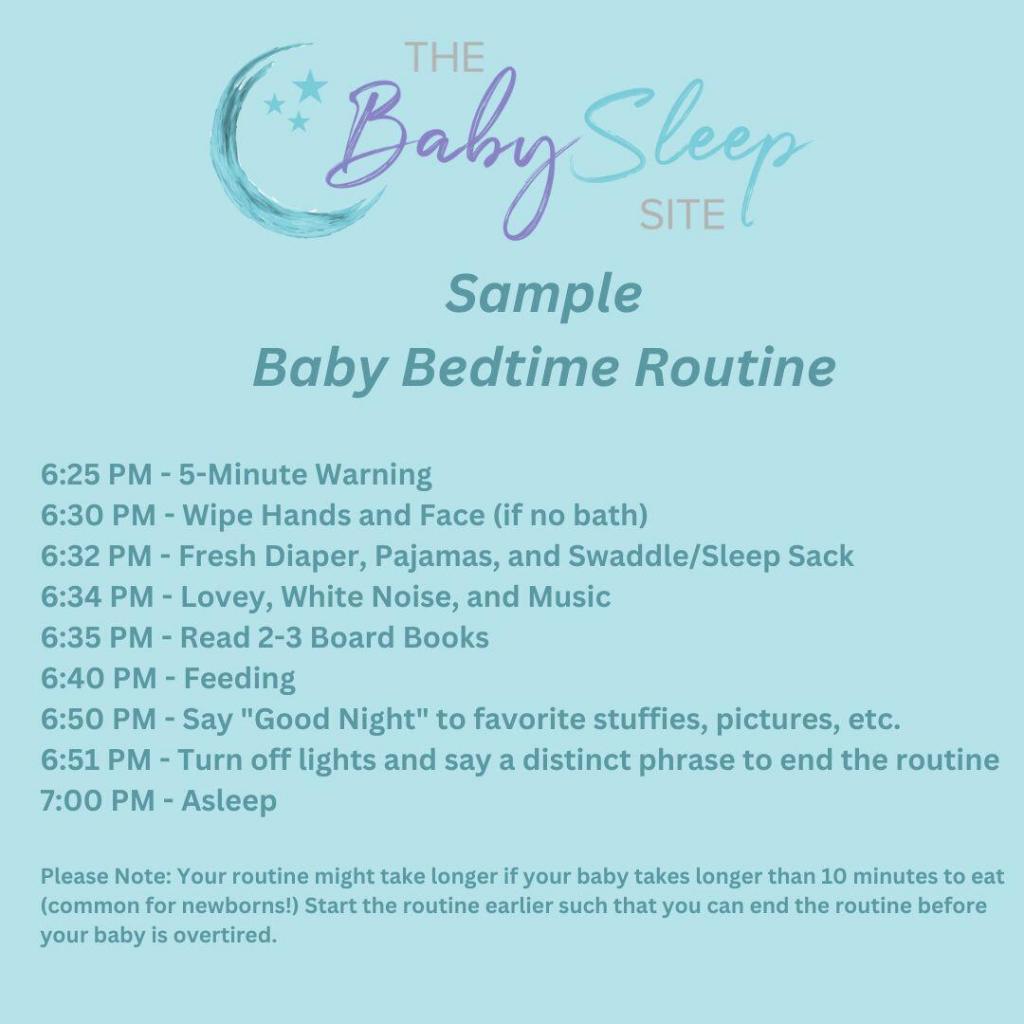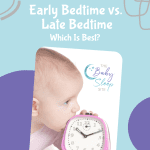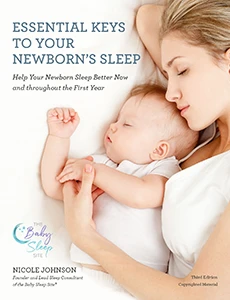
With a consistent baby bedtime routine, it’s often easier to put your baby to bed and your baby is more likely to sleep better at night. But, what should your bedtime routine include and what does it look like? Learn the perfect recipe and see a sample based on my 15+ years as a baby sleep consultant.
What Age to Start a Baby Bedtime Routine
For most babies, you’ll want to start a baby bedtime routine once they are around 6-8 weeks old. Starting a bedtime routine will cue them that sleep is on the horizon and most babies will start to relax even before you’re done!
However, there is no right or wrong age to start a bedtime routine for your baby. So, if your baby is older, don’t worry! There is still hope to create a perfect routine.
How Long is a Good Routine?
Bedtime routines generally don’t have to be too long but you want it long enough that your baby can successfully fall asleep faster. As counter-intuitive as it may seem, bedtime routines typically get longer as your child gets older. Here are the average lengths for bedtime routines based on my experience:
- Newborns – Aside from feedings which can vary widely in length at this age, newborn bedtime routines are typically 5-10 minutes long or shorter both during the day and at night.
- 4 to 15 Months Old – Babies and young toddlers typically have slightly longer bedtime routines. The average length is usually around 5-15 minutes before naps and 20-30 minutes before bedtime.
- 16 to 30 Months Old – Toddlers up to 2 1/2 years old typically have longer bedtime routines than babies. Sometimes this is because they want to do things themselves. Sometimes it’s because they explore their bedrooms that they haven’t been in for most of the day. Sometimes it’s just because they need more time to wind down. The average length of bedtime routines at this age is around 10-20 minutes before naps and 30-45 minutes at night.
- 2 1/2 Years Old and Older – Older toddlers and preschoolers tend to have the longest bedtime routines. So, be prepared for bedtime routines to be 30 to 60 minutes as your child gets older. This is often because they become very observant, they might be potty training, and they simply have more personality! Even a book you might have read a million times suddenly has more complexity to it. “Oh, look Mommy! The cloud on this page is a different shape than that page!” And, as your child gets even older, you’ll be reading chapter books before you know it and they will want “one more chapter.” My boys LOVED The Magic Treehouse series of books, for example! Speaking of that, many children will delay bedtime by having many requests for this or that.
No matter the age of your child, know that your child’s temperament will become a factor in how long it takes for them to wind down. As my son got older, the more I tried to rush him, the more it backfired and bedtime would take longer. When I embraced that he needed an hour to unwind no matter what, it was a much more pleasurable experience for both of us!
The Perfect Recipe for a Baby Bedtime Routine
What ingredients go into the perfect bedtime routine for your baby? Here they are:
- Consistency – If your routine is different every day, your baby won’t know what’s coming next.
- Calmness – The routine should be calming and not super exciting with upbeat music, for example. Also, no rough-housing, tickling, etc. shortly before you want your baby to fall asleep.
- Dim Lights – Some babies are very sensitive to lights so try to dim the room. Some parents solely use a nightlight.
- Quiet Activities – Most routines include quiet activities such as reading books and singing lullabies.
- The Right Timing – One of the most important things you can do for your routine is to time it correctly. Doing a bedtime routine at the wrong time can make it ineffective. Therefore, you want to make sure you follow an age-appropriate baby schedule.
Sample Baby Bedtime Routine – 10 Steps to Better Sleep
And, now for a sample bedtime routine that you can use at any age:
- Give a warning the bedtime routine will be starting in the next 5 minutes. This is a good time to start cleaning up toys if you have a toddler. This warning is important for slower-to-adapt babies and toddlers. If you have a newborn, feel free to make this a short “Time for bedtime” and graduate to 5-minute warnings as they get older.
- Give your child a bath or wipe their face and hands. Keep in mind that some children become excited and hyper with a bath so it’s possible you want to skip this step or make it a “pre-routine” step.
- Put on a fresh diaper or have them use the potty if you are doing Elimination Communication.
- Put on sleepwear including a swaddle or sleep sack.
- Give your child their lovey and turn on white noise and/or soft music. Please Note: White noise can play all night long but music is usually used only during the routine. This is because the change of sounds in music can disrupt sleep. White noise is usually monotonous which doesn’t have the same effect. If you choose to use a humidifier, be sure to follow recommendations on use and cleaning.
- Read books or do other quiet activities that your child likes. My sons loved Sandra Boynton’s books. We started reading at 4 months old but you can start whenever you feel ready!
- Feed your baby or toddler.
- Say “good night” to favorite toys and stuffies.
- Turn off all the lights and say a distinct phrase that signals the end of the routine. For example, you might say “Good night, sweetie. I love you. Time for bed.” This distinct phrase will help immensely as you help your baby become an independent sleeper!
- Rock or cuddle your baby in silence (or soft humming/singing if you prefer.) At this stage, they should be trying to fall asleep so your interaction should be minimal.
At this point, your routine is over and you will either put your baby all the way to sleep or put them down drowsy, but awake depending on where you are in your journey. Remember, do NOT put their lovey or anything IN bed with them until they are a year or older for safety.

I hope this post has helped you see that a good baby bedtime routine doesn’t have to be hard or complicated! It can be an enjoyable experience for both of you.








